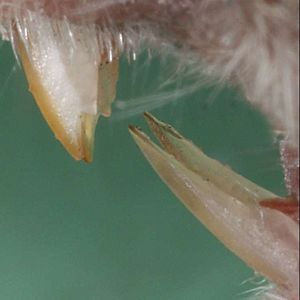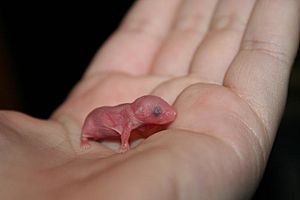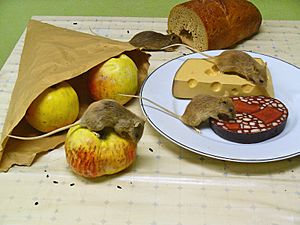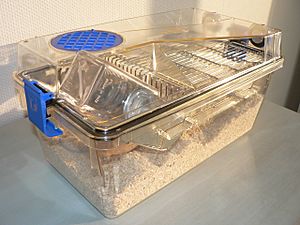House mouse facts for kids
The house mouse (Mus musculus) is a small rodent that you might just call a "mouse." These common mice live very close to people in most parts of the world. They are also super important in science! Many laboratory mice used for research in biology and medicine are actually house mice. They are the most common mammals used for experiments.
Quick facts for kids House mouse |
|
|---|---|
 |
|
| Scientific classification | |
| Kingdom: | |
| Class: | |
| Order: | |
| Family: | |
| Subfamily: | |
| Genus: | |
| Binomial name | |
| Mus musculus Linnaeus, 1758
|
|
Contents
What Does a House Mouse Look Like?
House mice are small, but they are not the smallest mammals. An adult house mouse is usually about 7.5 to 10 centimeters (3 to 3.9 inches) long from its nose to the base of its tail. Their tail adds another 5 to 10 centimeters (2 to 3.9 inches) to their length. They typically weigh between 10 and 25 grams (0.4 to 0.9 ounces).
In the wild, their fur can be light to dark brown. However, mice bred by humans can come in many other colors. They have short hair and moderately large, hairless ears. You can spot a distinct notch in their upper front teeth, which is easiest to see from the side.
How Their Bodies Work
Small mammals like mice have a large surface area compared to their mass (how much they weigh). This means they lose heat quickly from their bodies. To stay warm, they have special ways to keep their body temperature normal.
They need to eat often to get enough energy. They also prefer to live in places that protect them from cold weather. Because they need easy access to good food like grains and a safe home, they often live in large numbers near human settlements.
Life Cycle and Reproduction
In the wild, house mice usually live for about one year. Many small carnivores (meat-eating animals) hunt and eat them. However, mice reproduce very quickly, which helps keep their numbers high.
A female mouse can have 3 to 14 babies in one litter (a group of babies born at the same time). She can have 5 to 10 litters each year! When conditions are good, the mouse population can grow very fast.
Where House Mice Live
House mice were not originally from North America. They arrived there by accident on ships in seaport towns. Now, they are found all over the United States. They live either as "commensal" animals or "feral" animals.
- Commensal mice live very closely with humans. You can find them in houses, barns, stores, and other buildings.
- Feral mice live in the wild. They can be found in fields, near rivers, and in other places where there is thick plant growth to hide them.
Mouse Behavior
House mice usually walk or run on all four legs. But when they are eating, fighting, or looking around, they often stand up on their back legs. They use their tail for extra support, which is called "tripoding." Mice are good at jumping, climbing, and swimming. They also like to stay close to vertical surfaces, a behavior called "thigmotactic."
Mice are mostly active during twilight (dawn and dusk) or at night. They don't like bright lights. A mouse in captivity usually sleeps about 12.5 hours a day. They build nests from soft materials in hidden spots near food.
Mice are territorial, meaning they defend their living space. One dominant male usually lives with several females and their young. Dominant males respect each other's territories. If two or more males are kept together in a cage, they might fight unless they grew up together.
House mice mainly eat plants, but they are omnivores, meaning they eat both plants and animals. They even eat their own droppings to get nutrients made by bacteria in their intestines. Unlike many animals, house mice cannot vomit.
Mice are generally afraid of rats, which often hunt and eat them. However, in some forest areas, like in New Zealand and North America, rats and mice can live together. House mice are not very good at competing with other small mammals. So, they usually can't survive away from human homes if other small rodents are around. But in some places, like Australia, mice can live alongside other small rodent species.
Mice and Humans
House mice usually live near people, either inside or around houses and fields. They originally came from Asia, probably northern India. They spread to the eastern Mediterranean around 13,000 BC. They only spread to the rest of Europe around 1000 BC. Scientists think this delay happened because mice need human settlements that are big enough and have farms. Since then, humans have carried mice to every part of the world.
Scientists have studied mouse family trees to learn about how early humans moved around. For example, one study suggested a possible old link between Northern Europe and Madeira based on where mice in Madeira came from. Some people even believe that house mice were the main reason why the domestic cat became tame!
The first time pet mice were mentioned in writing was in an old Chinese dictionary called the Erya, around 1100 BC. Humans breeding mice led to many types of "fancy" or hobby mice. These pet mice come in different colors and are usually very calm. Domestic house mice are also raised as food for some carnivorous pet reptiles, birds, arthropods, and fish. Studies show that mice raised in captivity can become bolder and more active than wild mice in just a few generations.
When house mice get into homes, they can cause damage to furniture and the building itself. They gnaw on different materials to keep their constantly growing teeth short. Common damage includes chewed electrical wires, marks on wooden furniture, and torn fabrics.
Images for kids
-
In both farm and city areas, house mice are often hunted by the domestic cat, like this ragdoll cat. Here, it's stunning a mouse during the hunt.
See also
 In Spanish: Ratón casero para niños
In Spanish: Ratón casero para niños









